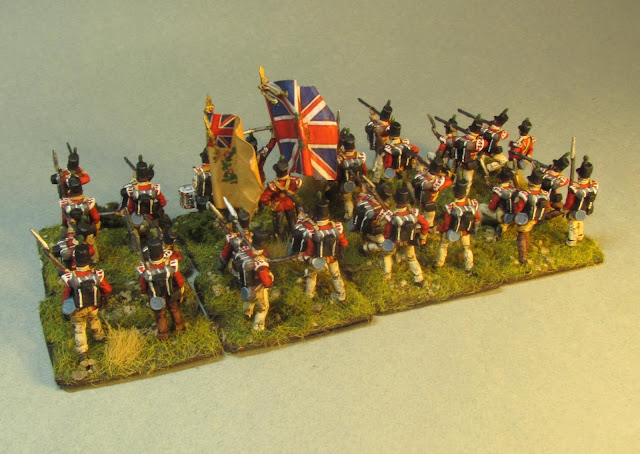In finishing painting the 52nd Light Infantry I have finally completed my goal set over a year ago to put together Crauford’s Light Division. My build of the 1/52nd was based on the Italeri figures I have used elsewhere in my British army. Although actually designed as a Waterloo era set, half the figures, representing the 29th, wear stovepipe shakos. The other half, 1st Guards, required some work on the Belgic shakos to give them the proper shape. Only a few of the figures have wings, so I experimented with sculpting wings on those missing them and was quite happy with the result!
 |
| My 1/52nd in skirmish formation. |
 |
| These figures were also fitted out with homemade wings and altered shakos. |
 |
| Command stand. |
 |
| A better view showing the altered flag bearers. |
 |
| Fusilier stand with altered sergeant with rifle. |
A Bit of History
 |
| My finished Light Division on the field. |
The 52nd was originally raised as a line regiment in 1755, seeing action in the American War of Independence and the Anglo-Mysore Wars before their engagement in the Peninsular Wars. They were converted to light infantry in 1803 when the 1st Corps of Light Infantry was formed.
What was to become the Light Division went through various incarnations and arrangements, but at its heart were the 1/95th and 3/95th Rifles, the 1/43rd (Monmouthshire) and 1/52nd (Oxfordshire). Also part of the division at various times were Ross’s and Chestnut’s Horse Artillery troops, the 1st KGL Hussars, parts of the 14th and 16th Light Dragoons, 1st and 3rd Caçadores battalions and 1/17th and 2/17th Portuguese Line.
My version is the Division as it appeared in 1810 at the time of the Combat of the Côa on the Portuguese frontier when the 1st and 3rd Portuguese Caçadores had also joined the ranks.
The British regiments of the division were first brigaded in 1803 as the 1st Corps of Light Infantry, not being designated as the Light Division until several years later. They served Moore with distinction in Spain, notably keeping their discipline intact, fighting a series of rearguard actions during the exhausting and horrific British retreat back to Corunna.
Crauford’s brigade returned to Portugal, landing in Lisbon July 2, 1809 and after a gruelling march joining Wellesley just as the battle of Talavera was concluded. The Light Division went on to serve with distinction throughout the entire Peninsular War. Crauford himself, after a sojourn in England as a result of illness, returned to take command of the Division only to perish at the walls of Ciudad Rodrigo during the British siege of that city.







These look great. I hope to see them in some of your game reports.
ReplyDeleteHave you seen the new Strelets ‘firing line’ British set? They look good - but mostly for later in the wars.
Thanks. They will certainly make appearances in future game, were already in the Corunna game, although representing some other regiment.
ReplyDeleteI love the new Strelets sets, but sadly, as you say, they are all for Waterloo! Maybe worth the conversions…